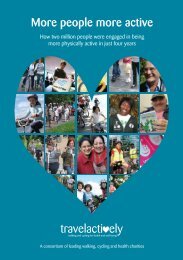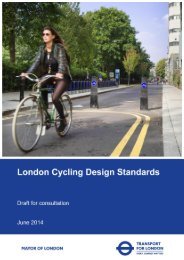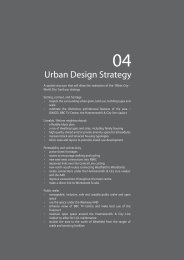Travel in London Travel in London
travel-in-london-report-8
travel-in-london-report-8
Create successful ePaper yourself
Turn your PDF publications into a flip-book with our unique Google optimized e-Paper software.
4. Performance of the transport networks<br />
Table 4.6<br />
Summary of key reliability <strong>in</strong>dicators for the pr<strong>in</strong>cipal public transport<br />
modes.<br />
Mode Units/measure 2008/09 2013/14 2014/15<br />
Underground Standardised journey time 43.9 43.4 42.3<br />
(m<strong>in</strong>utes)<br />
Underground Excess wait<strong>in</strong>g time (m<strong>in</strong>utes) 6.6 5.2 4.6<br />
<strong>London</strong> Buses Excess wait<strong>in</strong>g time for highfrequency<br />
1.1 1.0 1.1<br />
routes (m<strong>in</strong>utes)<br />
<strong>London</strong> Buses Low frequency routes –<br />
80.8 82.5 81.8<br />
percentage of buses on time<br />
DLR<br />
Percentage of tra<strong>in</strong>s that ran n/a 0.08 0.07<br />
to time<br />
<strong>London</strong> Traml<strong>in</strong>k Excess wait<strong>in</strong>g time 98.9 98.9 97.9<br />
National Rail<br />
<strong>London</strong><br />
Overground<br />
ORR’s PPM measure for L&SE<br />
operators (all services,<br />
average for year)<br />
ORR’s PPM measure (all<br />
services)<br />
91.0 89.6 89.0<br />
n/a 95.8 95.0<br />
Source: TfL Plann<strong>in</strong>g, Strategic Analysis.<br />
S<strong>in</strong>ce 2008/09, reliability <strong>in</strong>dicators across the pr<strong>in</strong>cipal transport modes have<br />
rema<strong>in</strong>ed consistently high. On the Underground, excess wait<strong>in</strong>g time decreased<br />
from 6.6 m<strong>in</strong>utes <strong>in</strong> 2008/09 to 4.6 m<strong>in</strong>utes <strong>in</strong> 2014/15, while for bus excess<br />
wait<strong>in</strong>g time for high-frequency routes was 1.1 m<strong>in</strong>utes <strong>in</strong> both years, although for<br />
much of the period this stood at 1.0 m<strong>in</strong>ute.<br />
4.11 Public transport capacity<br />
Over the most recent year Underground capacity has <strong>in</strong>creased by 0.7 per cent<br />
follow<strong>in</strong>g l<strong>in</strong>e upgrades and <strong>in</strong>creased off-peak service levels. <strong>London</strong> Traml<strong>in</strong>k<br />
capacity also <strong>in</strong>creased, by 4.3 per cent, while bus capacity <strong>in</strong>creased marg<strong>in</strong>ally, by<br />
0.2 per cent. There was a small decrease <strong>in</strong> DLR capacity, of 2.3 per cent, due to<br />
the more frequent use of longer tra<strong>in</strong>s dur<strong>in</strong>g the <strong>London</strong> 2012 Games; however<br />
capacity rema<strong>in</strong>s substantially greater than <strong>in</strong> 2011/12, follow<strong>in</strong>g the cont<strong>in</strong>ued roll<br />
out of three-car operation to the network.<br />
84 <strong>Travel</strong> <strong>in</strong> <strong>London</strong>, Report 8








